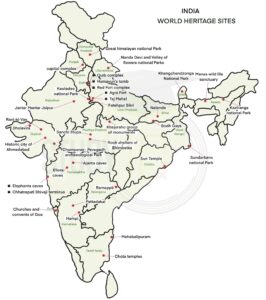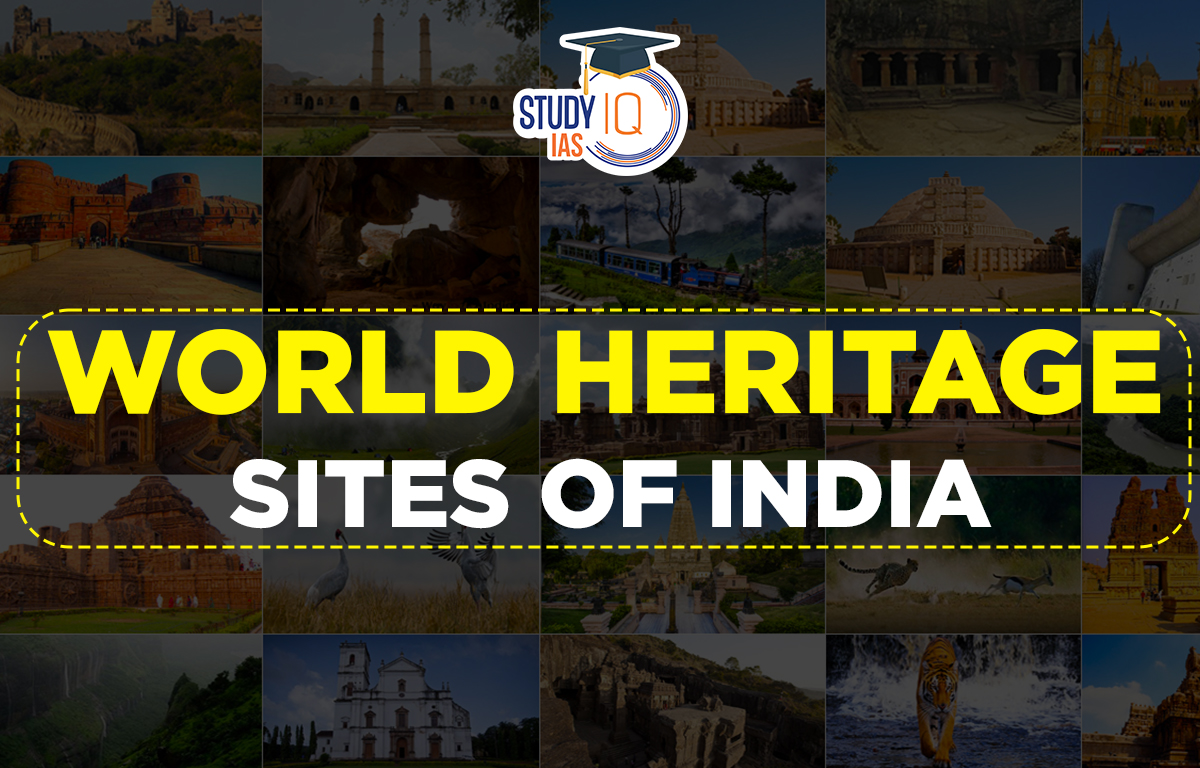| Name of the Site |
Added on Year |
Importance |
| Kaziranga National Park |
1985 |
- It has the world’s largest number of one-horned rhinos.
- Other animals include Elephants, wild water buffalo, and swamp deer.
- It is also an Important Bird Area by BirdLife International, Elephant Reserve under Project Elephant.
- It has the highest density of tigers among protected areas in the world and was made a Tiger Reserve in 2006.
- The vegetation here includes a vast expanse of tall elephant grass, marshland and dense tropical moist broadleaf forest
|
| Manas National Park |
1985 |
- It is a Wildlife sanctuary, Tiger Reserve, Elephant Reserve and Biosphere Reserve.
- Situated close to Himalayan foothills, near to Royal Manas National Park in Bhutan.
- It is known for its rare endemic species,
- Critically endangered – pigmy hog
- Endangered – Assam roofed turtle, hispid hare and golden langur
|
| Mahabodhi Temple Comple at Bodh Gaya |
2002 |
- Emperor Ashoka built the first temple around the Bodhi tree.
- The present temple is dated between the 5th and 6th centuries AD.
- It is built of bricks.
- It is the oldest temple in the Indian subcontinent, built during the Gupta Period.
- Some parts of the structure are preserved in the museum.
|
| Humayun’s Tomb |
1993 |
- Considered a precursor monument to the Taj Mahal.
- It was built in 1569-70 by Humayun’s widow Biga Begum.
- Its architecture was created by Mirza Ghiyath and its Mughal architectural style has been acclaimed as a “necropolis of the Mughal dynasty”, for its double domed elevation provided with Chhatris.
- The tomb is set on an irregular octagonal plinth.
- The tomb is built with a char-bagh layout with two gates, one on the south and the other on the west, a pavilion and a bath.
|
| Qutub Minar Complex |
1993 |
- Red sandstone tower of 72.5 m in height.
- Built at the beginning of the 13th century.
- The complex structure comprises
- Alai Darwaza
- Alai Minar
- Qubbat-ul-Islam mosque
- Tomb of Iltumish
- Iron Pillar
- Structures have been made from the remains of Hindu and Jain temples.
- Iron pillar has inscriptions in Sanskrit belonging to Chandra Gupta II’s period.
- Work started by Qutubuddin Aibak in 1192, completed by Iltutmish and again by Alauddin Khalji.
|
| Red Fort |
2007 |
- Built by emperor Shah Jahan as part of his new capital city of Shahjahanabad.
- A prominent example of Indo-Islamic architecture
- Planning and design of this complex in a geometrical grid plan with pavilion structures was the precursor of several monuments which were built later in Rajasthan, Delhi and Agra
- It is adjacent to Salimgarh fort on its north, built by Islam Shah Suri in 1546 and is now a part of the Red Fort complex
- Other important constructions in this complex include Diwan-i-Am, Diwan-i-khas, Nehr-i-Behishit, Moti Masjid (built by emperor Aurangzeb)
|
| Churches of Goa |
1986 |
- They were built between the 16th and 18th centuries by the Portuguese who ruled Goa during this time.
- Monuments are mainly in the former capital of Velha Goa or Old Goa
- Basilica of Bom Jesus – known for housing the remains of St. Francis Xavier
- Only some of the original monuments have survived, which include :
- Saint Catherine’s Chapel – where one of the first, Latin rite masses in Asia was held on Saint Catherine’s feast day i.e. 25 Nov 1510.
- Saint Francis of Assisi Church
- Basilica of Bom Jesus
- Church of Saint Cajetan and its seminary
- Church of Our Lady of Rosary
- Church of Saint Augustine
- Structures are built using laterite rocks and lime plaster
- For this reason they need constant maintenance and protection
|
| Champaner-Pavagarh |
2004 |
- Situated in the Panchmahal district of Gujrat.
- It is a late Stone Age site. It also has a hill fortress which belongs to ancient Hindu rulers.
- Kalikamata Temple on top of Pavagarh Hill attracts a large number of devotees
- This site is the only complete Islamic pre-Mughal city.
|
| Monuments of Hampi |
1986 |
- Hampi town is located on the bank of river Tungabhadra in Karnataka.
- The site consists of remains of Vijayanagara times.
- Many travellers between the 14th and 16th centuries have mentioned it in their travelogues.
- Virupaksha Temple and several other monuments.
- Vittala Temple is known for its musical pillars.
|
| Pattadakal Monuments |
1987 |
- The complex consists of Hindu and Jain temples. It is located in northern Karnataka.
- Virupaksha Temple
- Built-in 740 by Queen Lokamahadevi
- To mark the victory of king Vikramaditya II (her husband) victory over the Pallava ruler.
- Combination of temples built by the Chalukya Dynasty in the 6th and 8th centuries at Aihole, Badami and Pattadakal.
- Temples represent the fusion of Nagara and Dravida style
- Within the heritage complex
- Eight temples dedicated to Shiva
- Ninth Shaivite sanctuary called Papanath Temple
- A Jaina temple
|
| Sanchi, Madhya Pradesh |
1989 |
- Monuments dated around the 2nd century BC
- Built during the time of emperor Ashoka
- Historically it was a Buddhist religious site and remained active till about the 12th century.
- The complex has a number of monolithic pillars, temples and monasteries in different states of preservation
|
| Bhimbetka Rock Shelter |
2003 |
- Located at the foothills of the Vindhyan range
- They are sandstone shelters extending over an area of over 25,000 acres
- Shelters have paintings dated from palaeolithic to neolithic times.
- Villages surrounding them reflect tradition displayed in rock paintings
|
| Khajuraho Temples |
1986 |
- Built by rulers of the Chandela dynasty.
- Monuments belong to the Hindu and Jain religions.
- Of the 85 temples built, only 22 have survived, including Khandariya Temple.
- Temples are famous for their nagara-style of architecture and their erotic sculptures.
|
| Ajanta Caves |
1983 |
- Buddhist caves
- Built-in two phases
- The first phase from the 2nd century BC
- Second phase between the 5th and 6th centuries AD of the Gupta period
- Depict richly decorated paintings, and frescoes similar to Sigiriya paintings in Sri Lanka
|
| Ellora Caves |
1983 |
- Located in the Aurangabad district of Maharashtra
- The cultural mix of three religions Buddhism, Hinduism and Jainism can be seen here.
- Structures have been carved in basalt rocks
- Kailash temple is the most admired among them, which was built by Krishna-I of the Rashtrakuta dynasty.
- Structures are dated from 600 to 1000 AD
|
| Elephanta Caves |
1987 |
- Group of caves located on Elephanta Island or Gharapuri
- The islands are located near the western coast of India in the Arabian Sea
- It consists of two groups of caves
- The first group consist of Hindu caves
- The second group consist of Buddhist caves
- Hindu caves have sculptures of Shiva
- Caves are cut in basalt formations
|
| Chhatrapati Shivaji Terminus |
2004 |
- At present, Central Railways’ headquarter is located here.
- The station was designed in Gothic style in 1887-1888 by Frederick William Stevens and was built as the headquarters of the Great Indian Peninsular Railway.
|
| Sun Temple, Konark |
1984 |
- 13th-century temple
- Also known as “Black Pagoda”
- Located on the east coast of the Bay of Bengal in Mahanadi delta, Puri district, Odisha
- Built in the form of the chariot of Surya, with 24 wheels, heavily decorated with stone carvings. Six horses are shown pulling the chariot
- Constructed using sandstone by king Narasimhadeva I of the Eastern Ganga Dynasty.
|
| Keoladeo National Park |
1985 |
- It is located in western Rajasthan in the Bharatpur district.
- It is a National Park, bird sanctuary and Ramsar Wetland site.
- It is a human-made lake.
- It is famous for 364 species of wintering birds that arrive from Afghanistan, Turkmenistan, China and Siberia.
|
| Jantar Mantar, Jaipur |
2010 |
- It is an astronomical observatory built during the time of Maharaja Sawai Jai Singh.
- He built a total of five such structures at Delhi, Jaipur, Ujjain, Mathura and Varanasi.
- Jaipur observatory is best preserved. It has a number of astronomical observation instruments built in masonry.
|
| Great Living Chola Temples |
1987 |
- Built by Chola rulers of Tamil Nadu
- It is known for three great temples of the 11th and 12th centuries
- Brihadisvara Temple at Gangaikondacholapuram
- Built by Rajendra I
- Completed in 1035
- It is similar to the Brihasdisvara temple at Thanjavur in architecture and design
- 53 m high vimana, which is pointed upward
- It is in contrast with straight vimana at Thanjavur
- Brihadisvara Temple at Thanjavur
- It is a temple where Lord Shiva is worshipped
- Built by Raja Raja Chola I
- Completed in 1010
- Vimana rises to a height of 100ft
- Monolithic Nandi, having a height of about 13ft sits at its entrance
- The entire temple structure is made out of granite
- Temple has Chola paintings on walls around the sanctum
- Airavateshwara Temple at Darasuram
- The construction of this temple is credited to Rajaraja Chola II.
- Nearly 80 ft high vimana.
- Temple is dedicated to Lord Shiva, who is worshipped as Airavateshwara
|
| Group of Monumments, Mahaballipuram |
1984 |
- Built during the time of Pallava rulers
- Most of the monuments were built during the time of Mahendravarman also known as Mamalla
- The town has approximately forty monuments, including the largest open-air relief panel in the world
- The monuments inscribed are
- Ratha Temples
- Mandapas – Varaha cave temple
- Open air panel, Descent of the Ganges also known as Arjuna’s Penance
- Shore temple with thousands of sculptures praising lord Shiva
- Thirukadalmallai which is a temple dedicated to Lord Vishnu
|
| Agra Fort |
1983 |
- Also known as Red Fort of Agra
- Fort has located on the bank of river Yamuna, built using red sandstone
- It is surrounded by palaces, towers and mosques that were built from the 16th century onwards till the early 18th century
- The most important structures within the fort complex are
- Khas Mahal
- Shish Mahal
- Musamman Burj (an octagonal tower)
- Diwan-i-Khas
- Diwan-i-Am
- Mosque made of white marble
- Structures are examples of Indo-Islamic architecture
|
| Fatehpur Sikri |
1986 |
- Mughal emperor Akbar built it during the 16th century as his new capital city
- For nearly a decade it served as the capital of the empire
- It was abandoned due to a water crisis and unrest in north-west India
- Emperor shifted the capital to Lahore
- Akbar decided to construct it in 1571 on the same site where the birth of his son, Jahangir was predicted by saint Shaikh Salim Chisti
- Structures are built in the Mughal architectural style. Important ones include :
- Jama Masjid, one of the largest mosques in India
- Buland Darwaza
- Panch Mahal
- Tomb of Salim Chisti
- English traveller Ralph Fitch considered the city in 1585 as more populous and larger than London
- Its planning style became the inspiration for the design of Shahjahanabad.
|
| Taj Mahal |
1983 |
- It is a mausoleum and is considered one of the seven wonders of the world.
- In memory of his wife Begum Mumtaz Mahal, emperor Shahjahan built this structure
- Construction is done using white marble in the Mughal architectural style
- The architect was Ustad Ahmad Lahauri
- The tomb has an octagonal layout.
- Calligraphic inscriptions, pietra dura and arabesques add to its beauty
|
| Mountain Railways of India |
1999 |
- Consist of Darjeeling Himalayan Railway, Nilgiri Mountain Railway and Kalka-Shimla railway
- They were built during colonial times by the British government
- Other two mountain rails of India which are not in the UNESCO World Heritage Site list include
- Nilgiri Mountain Railway in South India
- Matheran Hill Railway in Maharashtra
|
| Nanda Devi and Valley of Flowers National Park |
1988 |
- Both of them are part of the Western Himalayas
- Valley of Flowers NP
- It is known for its endemic alpine flower meadows
- Located in the Chamoli district of Uttarakhand along Garhwal Himalayas
- It is also home to important fauna including
- Asian Black Bear (vulnerable)
- snow leopard (endangered)
- Himalayan brown bear (critically endangered)
- Blue sheep (least concern)
- Nanda Devi NP
- Mountains here have rugged terrain
- It is also a Biosphere Reserve
- It attracts a large number of bird-watchers every year
- Fauna is the same as in Valley of Flowers National Park
- They are located between Zaskar and Great Himalayan ranges
|
| Sunderbans National Park |
1987 |
- The largest mangrove forest in the world is located in an estuary.
- UNESCO World Heritage Site, Tiger Reserve, National Park and Biosphere Reserve
- Important species found here
- Bengal Tiger
- Saltwater crocodile (least concern)
|
| Western Ghats |
2012 |
- Also known as Sahyadri Mountains
- Among the world’s most important biodiversity hotspots
- It includes many National Parks, wildlife sanctuaries and reserve forests in states of
- Kerala
- Karnataka
- Tamil Nadu
- Maharashtra
- It includes the following subclusters
- Agasthyamalai
- Periyar
- Anamalai
- Nilgiri
- Talakaveri
- Kudremukh
- Sahyadri
|
| Hill Forts of Rajasthan |
2013 |
- They are a group of forts located on Aravallis mountain
- Represent the Rajput military hill architecture typology, a style that makes use of terrain’s defensive properties.
- They enclose large areas and often complete villages within them
- Consists of
- Chittorgarh fort
- Served as the capital of Mewar
- Captured by Mughal emperor Akbar in 1568
- The largest fort in Rajasthan
- Kumbhalgarh fort
- Built by Rana Kumbha during the 15th century
- Maharana Pratap was born here
- The total wall length is over 38 km, which is the second-largest after the Great Wall of China
- Ranthambore fort
- Lies within Ranthambore National Park
- Known for the valour and glory of Hammer Dev of the Chauhan dynasty
- Gagron fort
- Jhalawar district of Rajasthan
- It is situated on a hill and has a water conservation structure
- Amber fort
- Example of Hindu architectural style
- Constructed using red sandstone and marble
- It is a four-story building with a courtyard at each level
- It consists of Amber Palace and Jaigarh fort, which is connected by an underground passage.
- Jaisalmer fort
- The fort was built in 1156 by Rawal Jaisal, a Rajput king
- Fort is located in the Thar Desert on a hill called Trikuta
|
| Rani Ki Vav |
2014 |
- Located in Patan, Gujrat. It is a famous step well.
- It is known for its detailed sculptures and its large size.
- It consists of more than 500 sculptures of gods and goddesses.
- Most sculptures are in devotion to Vishnu in form of Dus-Avatars.
- Sculptures also include Nagkanya who is considered an Apsara, showcasing 16 different styles of makeup to look more attractive called solah-shringar.
|
| Great Himalayan National Park |
1987 |
- Located in the Kullu region of Himachal Pradesh
- Characterized by high alpine peaks, high meadows and riverine forests
- Many rivers originated from this National Park due to the melting of glaciers
|
| Nalanda |
2016 |
- This site consists of archaeological remains of an ancient educational institution.
- Nalanda university is said to flourish from the 3rd century BC to the 13th century CE
- Different structures found in this site include viharas, stupas, shrines and important artworks in clay, metal and stone.
- Bakhtiyar Khilji destroyed it in the 13th century
|
| Kanchenjunga National Park |
2016 |
- Located at the centre of Sikkim state
- It is also a Biosphere Reserve
- It has been listed by UNESCO in the Mixed Heritage category
- It has a rich diversity of physical landscapes which include plains, mountains, river valleys and a variety of forest types.
- It is home to Buddhist monasteries
- Zemu glacier is located here
- Flora
- Temperate broadleaf and mixed forests consisting of trees like fir, oaks, willow etc
- Shrubs and grassland vegetation are also found
- Many medicinal plants and herbs
- Fauna
- Musk deer, civet, red panda
- Snow leopard, Himalayan black bear
- Himalayan tahr, Himalayan blue sheep
- Wild dog, Tibetan wild-ass
- Sloth bear, goral, takin
- Third-highest mountain peak in the world, Kanchenjunga is located here
|
| The Architectural Sites of Le Corbusier |
2016 |
- Consists of different works of Le Corbusier
- It includes 17 transnational sites located across seven countries
|
| Ahmedabad, the Historic City |
2017 |
- The city was founded in the 15th century by Sultan Ahmad Shah
- Important structures that contribute to the cultural heritage of this city include mosques, temples, traditional houses, streets, water harvesting structures etc.
- The city has religious institutions belonging to Hinduism, Christianity, Zoroastrianism, Islam, Jainism and Buddhism which makes it a multi-religious city.
|
| Victorian Gothic and Art Deco Ensembles of Mumbai |
2018 |
- They are part of what is popularly known as the Churchgate area of Mumbai
- Most of these structures were built in the 1800s either by Indians or Britishers
- Some of the important structures include
- Bombay High Court
- Mahatma Jyotibai Phule Mandai also known as Crawford market
- Municipal Corporation Building
- Rajabai Clock Tower
|
| Jaipur City, Rajasthan |
2019 |
- The city was built in the 1700s by Maharaja Sawai Jai Singh
- The planning and architecture of the city are unique in the sense that it has Islamic, Hindu and Western elements
- Iconic places and structures include
- Amber Fort and Palace
- Bazaars of Jaipur which include Johari Bazaar and Bapu Bazaar
- Hawa Mahal
- Govind Dev ji temple
- Nahargarh fort
- City Palace
|



 List of Awards and Honours Received by N...
List of Awards and Honours Received by N...
 List of GI Tag Products in India 2025, S...
List of GI Tag Products in India 2025, S...
 Hurun Global Unicorn Index 2025: Key Hig...
Hurun Global Unicorn Index 2025: Key Hig...





















